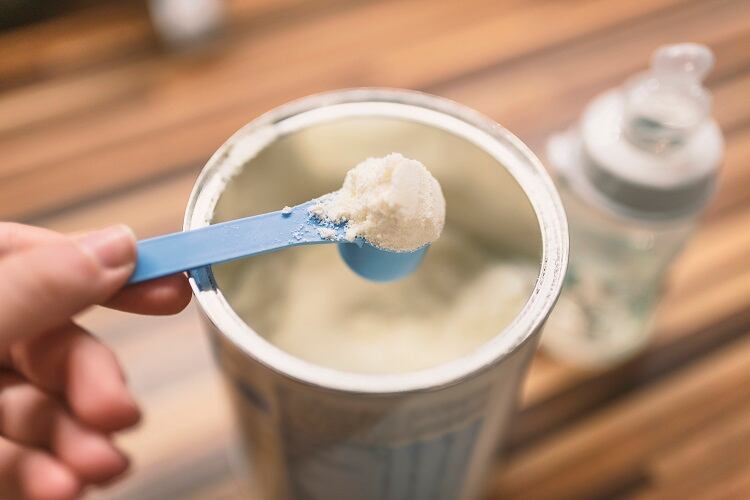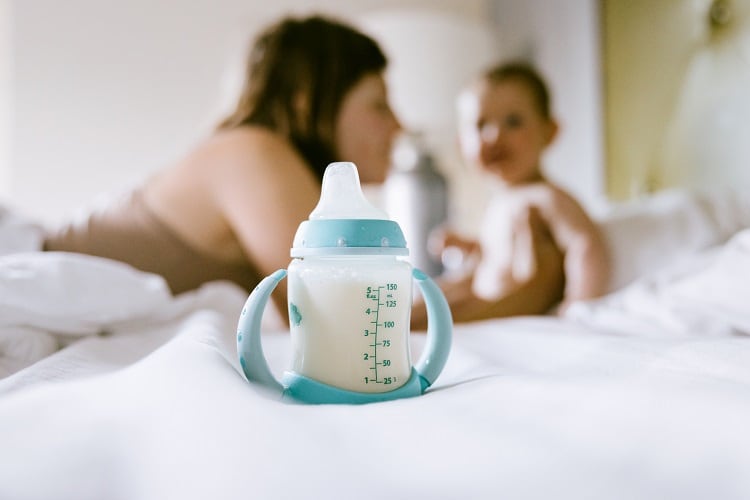Breastmilk is the ideal food for infants. According to the World Health Organization (WHO), it is safe, clean, and contains antibodies which help protect against childhood illnesses.
“Breastmilk provides all the energy and nutrients that the infant needs for the first months of life, and it continues to provide up to half or more of a child’s nutritional needs during the second half of the first year, and up to one third during the second year,” notes the UN agency.
Yet nearly two out of three infants are not exclusively breastfed for the recommended six months. When mothers are unable to – or choose not to – breastfeed, they turn to infant formula.
As it stands, the market is dominated by infant formula based on bovine milk, with a small percentage based on plant-based ingredients. If, as the experts say, ‘breast is best’, can industry move closer to replicating the real thing?
Is bovine milk the best option?
Bovine milk infant formula is big business. According to Business Research Insights, the global cow milk infant formula market size was valued at $21.49bn in 2021 and is predicted to touch $26.92bn by 2028.
In cow’s milk, the whey:casein protein ratio is 20:80. As breastmilk is whey-dominant, cow’s milk’s whey:casein ratio is altered – usually to 60:40 – to bring it closer to that found in breastmilk. Additional nutrients are also added, since babies require a greater quantity to that found naturally in bovine milk.
“Today, more than 95% of the infant food industry is based on bovine milk and the rest is based on soybeans and rice,” according to Hamutal Yitzhak, co-founder and CEO of Else Nutrition in Israel.
“There is no doubt that breast is best’. This is undisputed. But is bovine milk the best source of ingredients to mimic or replicate human milk?”
Else Nutrition is challenging this paradigm. Instead of replicating the ingredients of human milk, the start-up is working to ‘duplicate the benefits’ of human milk as a ‘whole substance’. In human milk, Yitzhak suggested, the ‘whole is greater than the sum of its parts’.
“Our technology is looking at human milk as a whole and at the benefits of it. We’re not trying to replicate a specific ingredient, because it contains hundreds of different substances and we’ll probably never be able to mimic it completely…So why not look at the benefits of it; why not look at the outcome rather than the input,” she told delegates at the Future Food-Tech event in London.
The start-up is working to mimic the ‘overall benefits’ of human milk on the digestion system and plans to prove this in the clinic. It is doing this with a 100% plant-based formula – rich in ‘healthy fat’, gluten-free carbohydrates, and essential vitamins and minerals – made from more than 80% almonds, buckwheat and tapioca.
‘Natural’ and ‘wholesome’ vs cellular agriculture
Given the undisputed compositional differences between human milk and cow’s milk, the ‘only way’ to make the latter mimic breastmilk, according to Yitzhak, would be to isolate each component and reconstitute it in a different way.
But for the Else Nutrition co-founder, this practice would be ‘synthetic’ and ‘not what nature intended’.
In the US, infant nutrition challenger brand ByHeart is also taking what it describes as the ‘natural’ approach. “Breast milk is the most functional nutrition, but it’s also the most natural,” said ByHeart co-founder and president Mia Funt.
“We find that parents are looking for the functional benefits of breast milk, but as this is for the most vulnerable population…clean and natural is also another goal of theirs.”
First, ByHeart uses an 80:20 whey to casein ratio, which is very similar to early breast milk (colostrum). Also similar to breast milk, they use lactose as a primary carbohydrate.
ByHeart aims to use the most ‘wholesome’ and ‘naturally derived’ ingredients possible. Its protein blend is non-GMO and contains two of the most abundant proteins is breastmilk: alpha-lactalbumin and lactoferrin.
In human milk, lactoferrin content stands at around 1.4mg/ml. It helps babies absorb iron and acts as an antimicrobial and antiviral agent. Yet achieving similar concentrations in infant formula is a challenge.
In infant formulas based on cow’s milk, lactoferrin can be significantly inferior – at as little as 0.1mg/ml. ByHeart’s infant formula contains less than 1% lactoferrin. In soy-based formulas, no lactoferrin is present.

Fengru Lin, founder and CEO of TurtleTree in Singapore, is taking a very different approach to both Else Nutrition and ByHeart.
The biotech start-up, which has operations in Singapore and the US, is leveraging cellular agriculture to develop cultivated dairy and recently announced production of the ‘world’s first’ bovine lactoferrin created using precision fermentation technology.
“What is available on the market today for infant nutrition is what you can get out of bovine milk,” explained Lin. “But the goal of infant nutrition is really to get as close to human milk as possible.”
As an ingredient, lactoferrin can be prohibitively expensive – ranging from $300-$3,000 per kg. Price volatility is another challenge in this market, due to fluctuations in supply and demand.
“At TurtleTree, what we’re addressing is being able to produce lactoferrin at a consistent price point – at the lower end of this spectrum,” explained Lin, “so we are able to make it accessible to the rest of the world”.
Innovating in the ‘most highly regulated’ industry in the world
That is not to say that TurtleTree’s lactoferrin ingredient is on the market: as a novel food, it will require pre-market authorisation. However, the company says it has ‘already made ground’ with regulators.
Whether leveraging ‘new’ or traditional ingredients, regulation is a major hurdle for innovators rethinking infant nutrition.
Innovating in the infant nutrition category is ‘not for the faint of heart’, stressed ByHeart’s Funt at the Future Food-Tech event.
“We’re talking about innovating the most highly regulated food in the world.”
In the US, where ByHeart operates, bringing an innovative infant formula to market requires conducting clinical trials and receiving FDA registration. Another issue lies in contract manufacturing, she explained.
“There is only one full-service contract manufacturer in the US, [meaning that] every other challenger brand has gone to that one contract manufacturer – which has really limited their ability to innovate.”
This forced ByHeart to take a different approach. After five years of product development, ByHeart launched its first infant formula into the US market. The company owns and oversees its own manufacturing, making it one of only five manufacturers of infant formula in the US.
“When we got FDA regulation this year, we were the first new manufacturers in the last 15 years.”

Else Nutrition is also on the market in the US, selling ‘super cereal’ products to babies older than six months, ‘complete nutrition’ powders for toddlers, and ‘shake mixes’ for kids. “We are now processing Proof of Concept [products] for toddler and kid nutrition drinks in North America, while working on our FDA and European permits for infant formula,” explained Yitzhak.
“Once we get those permits, we will become the third option after dairy and soy options – which are the only sources of protein in the industry.”
But Else Nutrition is not there yet, and regulation remains ‘very challenging’ for challenger brands, Yitzhak stressed. “We had to prove the suitability and safety of the ingredients or the formula we are bringing to the table, and that is a huge challenge.”





